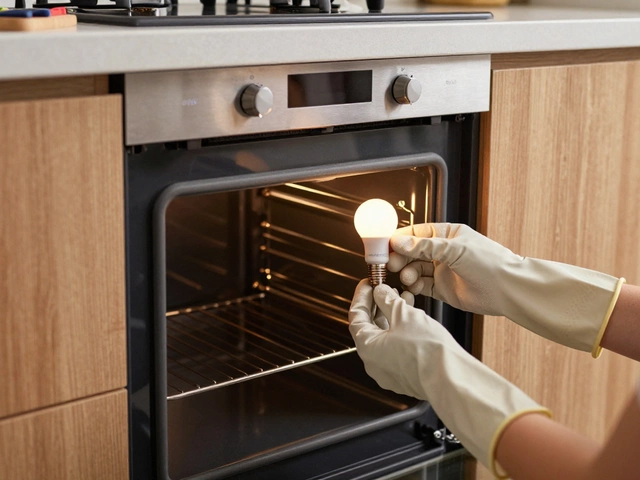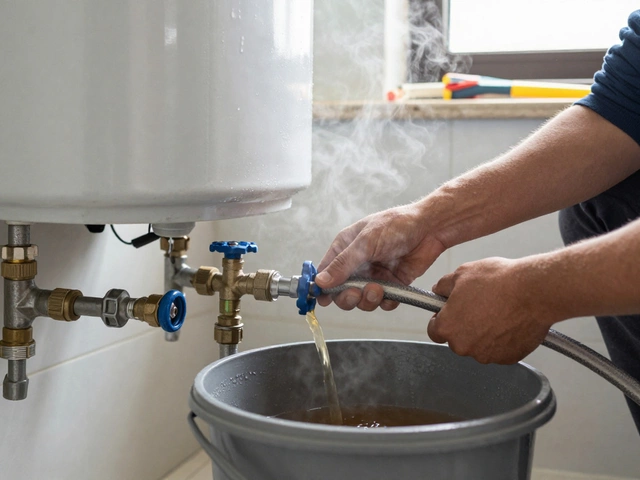Most people don’t think twice about the rules behind the fridge or washing machine humming away in the corner. But every appliance in your house needs to meet something called an 'appliance standard.' Why does this matter? Well, those standards are basically rules that say how safe and efficient each appliance has to be before it lands on a shop shelf or gets serviced in your home.
If you’ve ever wondered how your air fryer doesn’t catch fire (unless you really push your luck) or why your dishwasher doesn’t sound like an earthquake, thank appliance standards. They set the base level for safety, energy use, and how the thing is supposed to work. These rules protect you, your power bill, and sometimes your sanity. Ignore them, and you could end up with higher costs, dodgy repairs, or even dangerous results.
- What is an Appliance Standard?
- Why Standards Matter for Your Home
- How to Spot Compliance (and Why You Should)
- Common Myths about Appliance Standards
- Smart Tips When Getting Appliances Serviced
What is an Appliance Standard?
You might’ve seen the words appliance standard thrown around on labels or tech specs, but what does it actually mean? Simply put, it’s a set of rules or requirements every appliance—think washing machines, fridges, heat pumps—has to meet before being sold or serviced in your country. These standards are set by government agencies or international groups and they’re there to keep you safe, keep your power bill lower, and protect the planet while they're at it.
Let’s get specific: In New Zealand, most appliance standards follow the AS/NZS codes. That’s Australia/New Zealand Standard—meaning every microwave, heater, or blender that wants to be legit here has to pass the same baseline checks. Some of the big names you’ll see if you poke around the back of your toaster or under your washing machine include AS/NZS 60335 for electrical safety or AS/NZS 4474 for refrigerators and freezers.
These rules aren’t just about safety, either. Energy efficiency is a huge part of appliance standards now. Since 2002 in NZ, any fridge, washing machine, or dishwasher must meet certain efficiency standards before it gets to stores. That’s why you see those energy rating stickers—they’re your way of telling if an appliance will suck up extra electricity or keep your costs in check.
Appliance standards typically cover a few key things:
- Electrical safety—so your appliances don’t zap you or start a fire
- Efficiency—to curb electricity or water waste (which means lower bills)
- Environmental impact—making sure products last and don’t add heaps to landfill
- Noise levels—so your heat pump doesn’t wake up the whole street
Here’s a quick look at how appliance standards work for some common products:
| Appliance | Main Standard | What it Covers |
|---|---|---|
| Fridge/Freezer | AS/NZS 4474 | Energy use, safety, labeling |
| Washing Machine | AS/NZS 2040 | Efficiency, water use, safety |
| Heater | AS/NZS 60335 | Electrical safety |
| Air Conditioner | AS/NZS 3823 | Performance, energy rating |
So next time you buy, use, or get an appliance serviced, look for those codes and stickers. Meeting the right appliance standard isn’t just legal stuff—it’s your daily safety net.
Why Standards Matter for Your Home
If you’ve ever had an appliance break down and a technician points out it’s not up to code, it can feel like a bad joke. But appliance standard rules are there for a reason. They keep your family safe, your gear working properly, and your wallet from taking a hit on the power bill. In New Zealand, for example, appliances have to line up with the AS/NZS standards. These aren’t just empty rules—the government actually audits and pulls items that don’t cut it.
Take energy use. If your washing machine or dryer isn’t meeting minimum efficiency standards, you’ll see the difference on your electricity bill. An Energy Efficiency and Conservation Authority report found that standards have cut average household energy use in New Zealand by up to 20% over the last decade. That’s not spare change, that’s real money back in your pocket.
Safety is a huge reason standards are in place. Certified appliances are less likely to start a fire or give someone an electric shock. The New Zealand Electrical Code of Practice (NZECP) checks everything from wiring to how sturdy the plug is. It’s not just red tape, it’s peace of mind. As the Consumer NZ chief executive Jon Duffy bluntly put it:
"Without strong appliance standards, you’re rolling the dice with your family’s safety and your own wallet. These rules aren’t about making life harder—they’re about stopping disasters before they happen."
Here’s what’s on the line if you skip certified appliances or dodgy repairs:
- Bigger risk of house fires and injuries
- Climbing power bills from wasteful devices
- Insurance headaches if anything goes wrong
- Repairs that just don’t work, or break again fast
It’s simple: stick with appliances and service pros that meet the right appliance standard. A little homework up front saves a load of hassle, and maybe even your home, later on.

How to Spot Compliance (and Why You Should)
Ever stared at a jumble of stickers or numbers on your new washing machine and wondered if any of that actually means something? Turns out, it does. Spotting if an appliance is up to appliance standard is easier than you might think, and it can save you from headaches down the track. Here’s what to look for.
First, check for certification labels. In New Zealand, an electrical appliance usually comes with an approval mark, such as the Regulatory Compliance Mark (RCM). You’ll often see a logo that looks like a tick with a circle around it. That’s the local seal of approval saying, “Yep, this appliance passed the basic safety checks.”
- RCM mark: Proves compliance with NZ electrical safety standards.
- Energy rating label: You’ve seen those colorful stickers from one to six stars. More stars mean lower energy use.
- Supplier details: Legit brands put their contact details on the label somewhere. If it just says “imported by XYZ Ltd,” be careful.
When you’re getting an appliance serviced, ask the tech if they use approved parts. Reputable appliance service companies won’t install dodgy bits that skip the standard. If something feels off—maybe the repair guy shrugs when you bring up compliance—trust your gut and ask for proof.
| Compliance Label | What It Means |
|---|---|
| RCM Mark | Meets NZ/Australian safety standards |
| Energy Star Rating | Lower running costs and less energy used |
| Water Rating | Measures water efficiency (handy for washers, dishwashers) |
Why bother? For starters, non-compliant appliances can void your insurance if something goes wrong. Plus, you could end up with higher power bills or even risk a house fire—so spotting compliance isn’t just about ticking boxes, it’s about keeping your home safe. Next time you shop or book a repair, give those labels and ratings a second look.
Common Myths about Appliance Standards
Let’s clear up a few things people often get wrong about appliance standard rules. These aren’t just picky government guidelines or useless checklists. Here’s the real deal with some of the most common mix-ups I’ve heard, even from mates who work in construction.
- Myth 1: Standards are the Same Everywhere. This isn’t true. The rules for appliances in New Zealand aren’t always the same as those in Australia or the US. For example, the NZ Minimum Energy Performance Standards (MEPS) are tailored for local power supplies and climate needs.
- Myth 2: If It’s on Sale, It’s Compliant. Not always. Some imported appliances, especially from online sellers, might not meet all the local appliance standard and safety rules. I once spotted a toaster with a power cord that didn’t meet NZ’s requirements—one spark away from trouble.
- Myth 3: Standards Only Affect Energy Use. People focus on the energy stickers, but appliance standard rules cover more: fire resistance, wiring safety, noise levels, and even the types of refrigerants in fridges. They’re about the whole package, not just your power bill.
- Myth 4: Compliance Means Top Quality. Meeting the standard means an appliance is safe and legal, but it doesn’t guarantee it’s the best model out there. Some brands go well above the bar; others just scrape by. Read reviews and look at extra certifications if you want the best.
- Myth 5: Servicing by Anyone is Fine if it Works. Only technicians with the right certifications should be fixing certain appliances. Certified techs know the appliance standard requirements and keep your warranty safe. If you let just anyone pop open your heat pump, you risk dodgy repairs—or void warranties.
Here’s a quick look at where myths can sneak in and the reality behind them:
| Myth | Reality |
|---|---|
| Any appliance sold is compliant | Some imports aren’t. Always check certification labels like RCM in NZ. |
| Energy rating = all rules met | Appliances can have energy labels and still fail other safety standards. |
| Repairs by anyone | Legal repairs often require licensed technicians—especially for electrical work. |
Knowing the facts on appliance service and compliance can save you a lot of hassle, not to mention money in the long run. Don’t fall for the myths—double-check those labels and certifications before you buy or repair anything at home.

Smart Tips When Getting Appliances Serviced
Calling a technician can feel like stepping into the dark—will they actually know what they're doing? Whatever you do, don’t just open the door for anyone with a tool belt. It’s not just about fixing the broken part. You need to make sure your appliance stays within the right appliance standard or you could end up with issues down the track.
- Check their credentials. Always ask if the technician is certified or has the right qualifications. Top brands sometimes have 'approved service centres'—that means they’re clued up on all the ins and outs of appliance standards. If you’re in New Zealand, look up whether they’re registered with Electrical Workers Registration Board (EWRB).
- Ask about original parts. Swapping in generic parts can mess with efficiency or even void your warranty. Insist on OEM (original equipment manufacturer) parts so your appliance still meets its standard.
- Get a clear breakdown of the job. Ask the repairer to explain exactly what they’ll do. This isn’t just about trust—sometimes cheaper service jobs skip key safety checks that are part of the required appliance standard.
- Request compliance checks. After the service is done, see if your technician can confirm the appliance still meets all required standards—especially for things like fridges, washing machines, and heaters. This helps keep you covered for both insurance and safety.
- Keep your paperwork. Hang onto any service records or compliance certificates. If something goes wrong later, you’ll need proof everything was done right.
Here’s a quick snapshot of some key standards for common appliances in New Zealand, so you know what to ask about:
| Appliance | Standard | Common Checks |
|---|---|---|
| Washing Machine | AS/NZS 60335.2.7 | Leak tests, safety trips, wiring check |
| Fridge | AS/NZS 60335.2.24 | Seal check, compressor test, thermostat calibration |
| Electric Oven | AS/NZS 60335.2.6 | Element safety, door lock, insulation resistance |
If a technician shrugs when you ask about standards, that’s a massive red flag. Trust your gut—if you feel dodgy about the service, get a second opinion. Sticking to these tips means your appliances stay in top shape, safer, and probably last a lot longer.









